How to Do a Furnace Tune-Up: The Ultimate Guide
How to Do a Furnace Tune-Up: The Ultimate Guide
To properly maintain your furnace, it is essential to do a proper furnace tune-up. This annual maintenance task should be performed every spring or fall, depending on the heating system installed in your home. An improperly working furnace can cause problems such as uneven heat distribution, excessive noise, damage to the unit itself, and expensive repair bills.
Photo Credit: https://www.fourseasonsheatingcooling.com/
A furnace tune-up consists of a number of tasks ranging from checking various components inside the furnace to cleaning the air ducts.
Check For Clogs
Before doing any other service, start with the most obvious one. If there are clogs in the furnace, the problem will immediately prevent the fan from running smoothly. This is especially true for furnaces with forced induction systems. To detect these clogs, turn off the gas supply, open the damper, and run the blower for about 30 minutes. Afterward, shut down the fan and remove the air filter. Then, inspect the filter with a flashlight. If it has accumulated too much debris, replace it immediately.
Clean Air Ductwork
Now that you've cleared out the air filter, check to see if the ductwork needs to be cleaned. If so, you can use a vacuum cleaner to clean the ducts. Make sure it's connected to a suction line, but don't leave it unattended. Be careful using this tool since it's heavy. It could easily tip over and spill dirt back into the furnace. Instead, find another person to help you.
Replace Filters - If the filters are dirty, they must replace. But wait until after the heating season ends before replacing them. Also, make sure the filters aren't cracked or damaged.
Inspect Fan Components - Once the filters are changed, take a close glance at all the parts that make up the furnace fan. These include the motor, bearings, fans, blades, vanes, impeller, and shrouds. All these parts need to be inspected to ensure they're in good shape. Simply put, you want to test each component to see whether it works correctly.
Install Thermostat
Finally, install a thermostat. It is an important step because your furnace won't automatically switch on during cold weather conditions without one. As a result, you may end up wasting money on fuel.
Also, set the temperature control knob to minimum or low. If you set it higher, the furnace may not cool down fast enough.
Start Blowing Again
Turn your furnace back on and let it run for approximately 10 minutes. Then, use the blower to blow out the remaining dust particles trapped in its internal components.
After completing the above tasks, you're ready to keep your furnace functional for the upcoming months.




Comments
Post a Comment